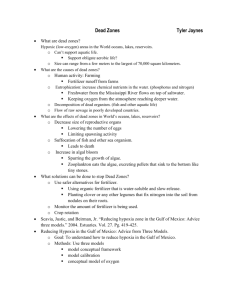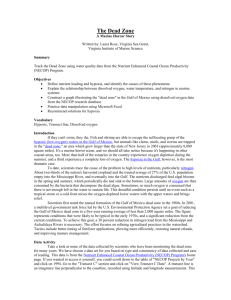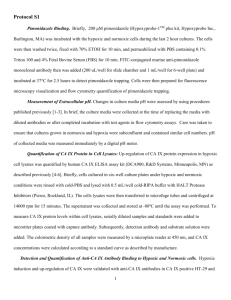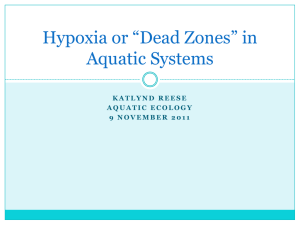Hypoxia is the name
advertisement
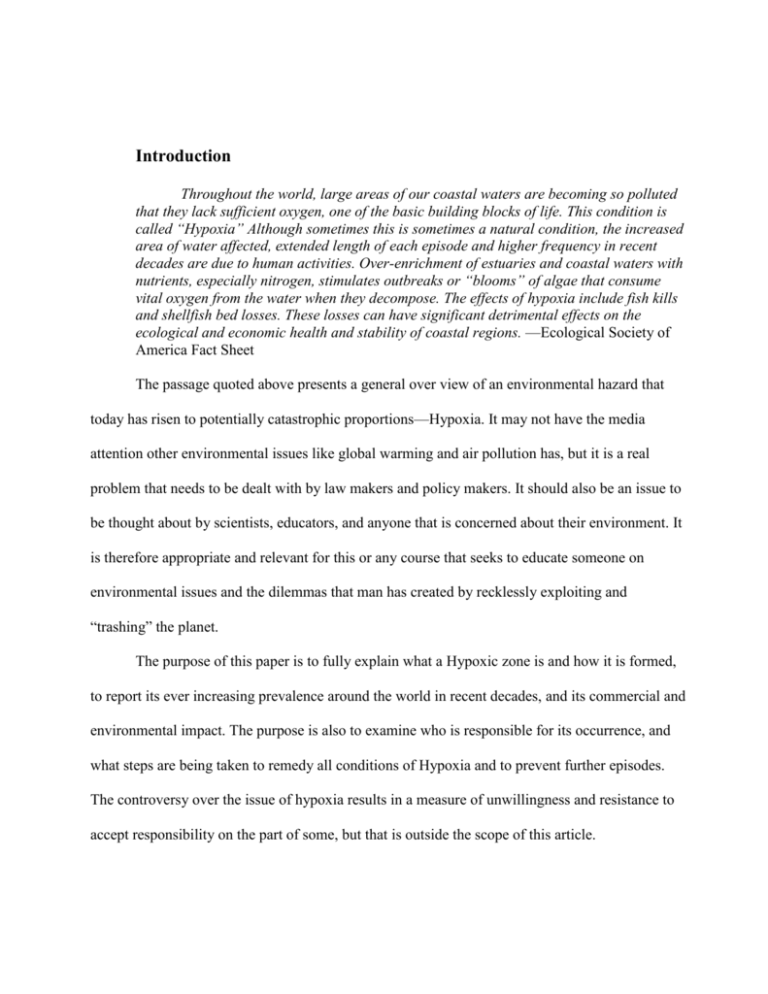
Introduction Throughout the world, large areas of our coastal waters are becoming so polluted that they lack sufficient oxygen, one of the basic building blocks of life. This condition is called “Hypoxia” Although sometimes this is sometimes a natural condition, the increased area of water affected, extended length of each episode and higher frequency in recent decades are due to human activities. Over-enrichment of estuaries and coastal waters with nutrients, especially nitrogen, stimulates outbreaks or “blooms” of algae that consume vital oxygen from the water when they decompose. The effects of hypoxia include fish kills and shellfish bed losses. These losses can have significant detrimental effects on the ecological and economic health and stability of coastal regions. —Ecological Society of America Fact Sheet The passage quoted above presents a general over view of an environmental hazard that today has risen to potentially catastrophic proportions—Hypoxia. It may not have the media attention other environmental issues like global warming and air pollution has, but it is a real problem that needs to be dealt with by law makers and policy makers. It should also be an issue to be thought about by scientists, educators, and anyone that is concerned about their environment. It is therefore appropriate and relevant for this or any course that seeks to educate someone on environmental issues and the dilemmas that man has created by recklessly exploiting and “trashing” the planet. The purpose of this paper is to fully explain what a Hypoxic zone is and how it is formed, to report its ever increasing prevalence around the world in recent decades, and its commercial and environmental impact. The purpose is also to examine who is responsible for its occurrence, and what steps are being taken to remedy all conditions of Hypoxia and to prevent further episodes. The controversy over the issue of hypoxia results in a measure of unwillingness and resistance to accept responsibility on the part of some, but that is outside the scope of this article. Hypoxia is the name Hypoxia is the name given to a condition that exists when the levels of available oxygen in a body of water such that marine life inhabiting the area is stressed. This stress might take the form of forced migration or mass mortality. The affected areas become incapable of supporting marine life. The condition in most cases is not continuous or permanent, but rather seasonal. Most hypoxic conditions seem to occur during the start of the summer months when it starts to get warm. Under normal conditions (normal in this case referring to the absence of any human activity), the levels of dissolved oxygen (DO) can fluctuate periodically with temperature changes (Table 1), but the Table 1- Maximum dissolved oxygen levels Temperature (° C) 0 1 2 3 4 5 6 7 8 9 10 11 12 13 14 15 16 17 18 19 20 21 22 DO (mg/l) 14.60 14.19 13.81 13.44 13.09 12.75 12.43 12.12 11.83 11.55 11.27 11.01 10.76 10.52 10.29 10.07 9.85 9.65 9.45 9.26 9.07 8.90 8.72 Temperature DO (° C) (mg/l 23 8.56 24 8.40 25 8.24 26 8.09 27 7.95 28 7.81 29 7.67 30 7.54 31 7.41 32 7.28 33 7.16 34 7.16 35 6.93 36 6.82 37 6.71 38 6.61 39 6.51 40 6.41 41 6.41 42 6.22 43 6.13 44 6.04 45 5.95 Source: Environmental Protection Agency levels tend to remain constant over time. Factors that affect DO levels include temperature, altitude, and whether the body of water moves vigorously or remains still. The colder the water temperature, the higher the DO levels will be. Higher altitudes also mean lower DO levels. At higher altitudes, there is less oxygen to mix with water. The action of the body of water also determines the level of oxygen it is likely to contain. Churning, fast moving waters tend to mix oxygen from the air better than waters that are calm or still (such as lakes or ponds). Besides the oxygen from the air that mixes with the water, another supply of DO comes from the photosynthesis of aquatic plants. Other factors include wind and rain. The conditions that lead to the creation of a Hypoxic zone usually varies significantly from normal conditions and these conditions tend to get very complex as it involves the acceleration of biological activity, which consumes the DO at a rate that exceeds the ability of the aquatic ecosystem to replenish the oxygen that is used. Under hypoxic (insufficient oxygen), or anoxic (no oxygen) conditions, “oxygen depletion results from the combination of several physical and biological processes.” (Rabalais, 1998) Hypoxic conditions begin miles away from the scene of coastal waters, where nitrogen and other types of nutrients (i.e. phosphorus) from fertilizer used by farmers to grow their crops and other organic waste pollutants from factories and other sources end up in the ground water and get transported downstream where they eventually find their way down to the coastal waters. “As a general rule, the nutrients delivered to the estuaries and coastal systems support biological productivity. Excessive levels of nutrients however, can cause intense biological productivity that depletes oxygen.” (Rabalais, 1998) The nature and scope of the hypoxia problem since its discovery in the 1950’s continue to alarm scientists, environmentalists, government agencies, educational institutions and the public. Though hypoxia conditions have been observed world-wide, it is the result of hypoxic conditions right here in our own coastal waters that has raised our own awareness and concern for the progressively worsening state of the marine environment and its impact on marine life. In 1970, the most important hypoxic zone —the Hypoxia in the Northern Gulf of Mexico, began to alarm scientists at Louisiana State University, in particular Dr. Nancy Rabalais, who to this day continues to study it: Midsummer coastal hypoxia in the Northern Gulf of Mexico was first recorded in the early 1970’s. In recent years (1993-1999), the extent of bottom-water hypoxia (16000 to 20000 km2) has been much greater than the surface area of Chesapeake Bay, rivaling extensive hypoxic/anoxic regions of the Baltic and Black Seas. Prior to 1993, the hypoxic zone averaged 8000 to 9000 km2 (1985-1992 Rabalais et al, 1998, and 1990). The hypoxic area covered 12,400 km2 in 1998, about the size of Connecticut. Conditions necessary for Hypoxia Anthropogenic activity (activity caused or produced by humans) is a pre-condition of hypoxia. The most common means of creating a hypoxic event is by excessive use of fertilizers that contain nitrogen and phosphorus in the growing of crops. When the soil contains very high levels of nutrients, irrigation and groundwater carry the nutrients down stream until they reach the coast. The river discharges into coastal waters carrying the nutrients that fall to the bottom. Next, the biological and physical processes described earlier (Rabalais) will bring about ecosystem changes that lead to formation of hypoxic zone, such as the hypoxic zone in the Gulf of Mexico. While the oxygen is being consumed by the decomposition of the algae bloom, external factors that contribute to the replenishing of oxygen and allow it to mix well with the water are not present. Consequently, the DO does not get replaced to the levels suitable to sustain marine life. These conditions are present during the hypoxic event. Now let’s see how a Hypoxic Zone is formed. Death in a nutshell: One picture is worth a thousand words. Source Louisiana University Marine Consortium (LUMCON) http://www.gulfhypoxia.net/research/ Hypoxia around the world Though the world’s attention is on the Northern Gulf of Mexico hypoxic event and on the work of Dr. Nancy Rabalais and other LUNCOM scientists, it is not the only hypoxic event. Hundreds have in fact been reported since the 1970’s and while an accurate inventory of hypoxic events have been taken, a great difference in the actual number reported by different sources exist. For example, Janet Larsen of the Earth Policy Institute assesses the number at 146: Worldwide, there are some 146 dead zones—areas of water that are too low in dissolved oxygen to sustain life. Since the 1960s, the number of dead zones has doubled each decade. Many are seasonal, but some of the low-oxygen areas persist year-round. (Larsen, 2004) By contrast, this report of the United Nations Environmental Programme indicated a much higher figure: A review of global hypoxic and anoxic zones (estimated at 375) could be undertaken to determine a subset of those with major nitrogen mediated impacts, out of which a short list of between 10 and 15 would be selected for further assessment and possible pilot activities (UNEP-GPA, 2007). The environmental impact of Hypoxia Large numbers of studies have been made on Hypoxia. The studies made of the Northern Gulf of Mexico Hypoxia by Dr. Rabalais are probably the most thorough and according to her leave “little doubt that human population growth and its associated activities have altered the landscape” (Luncom, 2008). Excess nutrients are finding their way to the coastal ocean in increasing amounts especially during the last half of the 20th century. There are thresholds of nutrient loading above which the nutrient inputs no longer stimulate entirely positive responses from the ecosystem such as increased fisheries production. Instead, land-based sources of nutrients are causing problems, for example, poor water quality, noxious algal blooms, oxygen depletion and in some cases, loss of fisheries production. Over the last four decades it has become increasingly apparent that the effects of excess nutrients that lead to eutrophication are not minor and localized, but have large-scale implications and are spreading rapidly (Luncom, 2008). What’s being done? In 2000, the Environmental Protection Agency (EPA), under the mandate of Public Law 105-383, the Harmful Algal Bloom and Hypoxia Research and Control Act of 1998, gave a public notice of availability and request for public comment on a Draft Action Plan. The plan was authored by the Mississippi River/Gulf of Mexico Watershed National Task Force. The Action Plan contains a list of long and short term goals considered to be necessary to reduce the size of the Hypoxic Zone. The long term goals offer three alternative actions and results which are to be decided upon completion of a comment period. There are also short range goals that focus on assisting farmers and land owners with programs to help (i.e. Clean Water Grants) with reducing the amount of Nitrogen run-off to the Gulf of Mexico. The report highlights the results of scientific investigation previously conducted and describes a Hypoxic area in the Northern Gulf of Mexico occurring during the summer months. The size of this zone is reported to be 4000 square miles. It goes on to describe the causes of the Hypoxic zone as being predominantly due to nitrogen and phosphorus “run-off” from excessive fertilizer use by agriculture. What’s ahead? There is a measure of controversy and debate over the issue of Hypoxia with scientists (e.g. LUMCON), government agencies (e.g. NOAA, EPA) and environmentalists (e.g. The Ecological Society of America) on the one hand and farmers on the other. Mainstream scientific studies of the Gulf of Mexico Hypoxic Zone brought out irrefutable conclusions on the role of nitrogen fertilizers applied excessively to the soil during the growing of crops. I believe that farmers were amenable to the problem and seemed to concur with President Clinton’s Hypoxia Action Plan (as it’s sometimes called). It has called for nitrogen load reduction of 30% and also for a 30% reduction in the size of the hypoxic area in the Gulf of Mexico. The status of the plan is unclear, but a new Hypoxic Action Plan was published in November of 2007 with the intent of reviewing and restructuring the goals of the 2001 Plan. The response of the “The Voice of Agriculture” AKA the American Farm Bureau (AFB) to the 2001 Action Plan was highly unfavorable. It was decried for its alleged scientific inaccuracy, for its imposition upon agriculture to change its practices regarding the use of fertilizers, and it was also deemed unfair and unjust of the EPA to put the blame on agriculture for creating the Hypoxic conditions. This was the gist of two letters that the AFB submitted to the authors of the plan, the EPA Watershed Task Force. These letters reflected the indignation of the AFB over the technical concerns they had over the wording of the plan, mindless of the fact that the plan contained only suggestions to solicit feedback from the various interested parties and the public as to a final strategy. The letter from AFB Executive Director Richard Newpher lists seven “concerns” over the wording of the plan: 1. the adequacy of scientific analysis 2. the effect of a 20 to 40 percent nitrogen reduction in agriculture 3. the use of water-quality standards and TDMLs to protect the Gulf 4. the impact of river flow management on the hypoxic zone and other resources 5. the lack of any economic and social analysis, as required by law. 6. the composition of any task force that may continue to exist after the Action Plan has been finalized and 7. the lack of substantive involvement of state governors in the action plan If those two letters are any indication, there will not soon be a “common cause” to guide and persuade all those involved in agriculture in order to put aside their interests and “make peace with the land”. When you are put on the “spot” it’s difficult to “act in the best interest of the earth” (to borrow a phrase from juvenile law). Who shall be the “voice of the earth?” References Larsen, Janet. “Dead Zones Increasing in World's Coastal Waters” 2004. The Earth Policy Institute- http://www.earth-policy.org/Updates/Update41.htm. Newpher, Richard. “Comments of the American Farm Bureau Federation on the Draft Plan of Action for Reducing, Mitigating, and Controlling Hypoxia in the Northern Gulf of Mexico” http://www.epa.gov/msbasin/taskforce/pdf/afbf.pdf Rabalais Nancy N. PhD. “Hypoxia in the Gulf of Mexico”National Oceanic and Atmospheric Administration http://www.csc.noaa.gov/products/gulfmex/html/rabalais.htm(1998). Anonymous. “Mississippi River Basin and Gulf of Mexico Hypoxia Draft Action Plan” Environmental Protection Agency (2000) http://www.epa.gov/mbasin/taskforce/draft.htm Anonymous. “Policies and part held during the 4th International Nitrogen Initiative Conference, 2 October 2007, United Nations Environment Programme(UNEP) http://www.gpa.unep/documents/ini_workshop_final_report_english.pdf Anonymous. “What_is_Eutrophication?” Louisiana Universities Marine Consortium (Lumcon), 2008. http://www.gulfhypoxia.net/research/#What_is_Eutrophication


